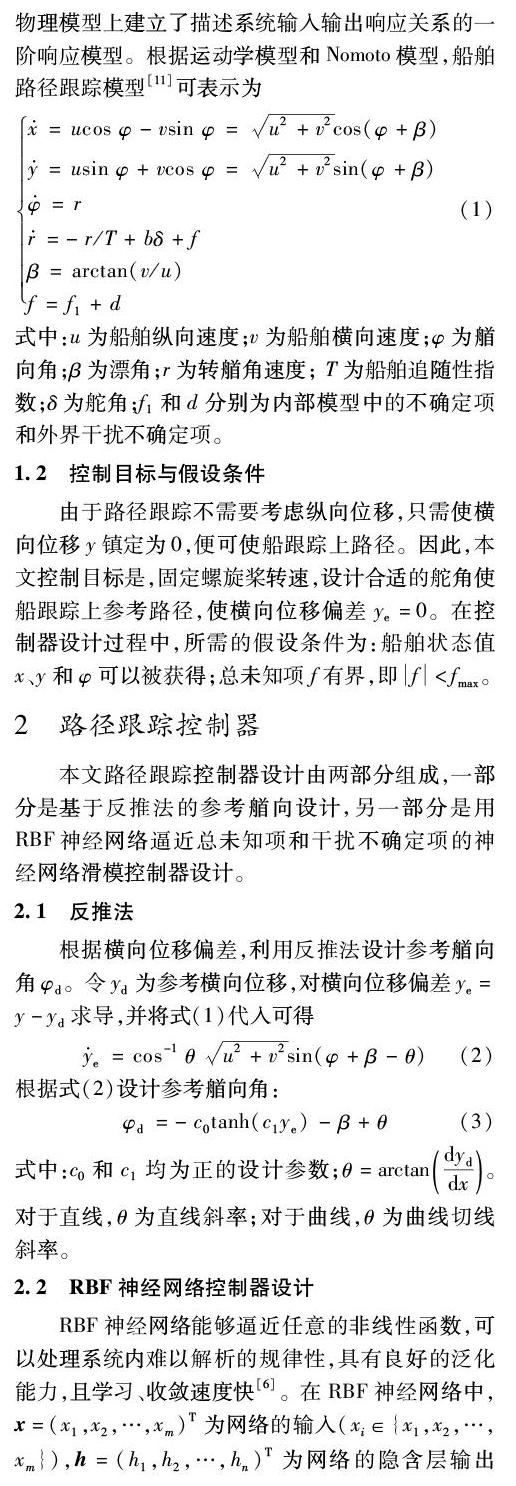船舶路徑跟蹤RBF神經網絡滑模控制
章滬淦 卜仁祥 于鎵銘

摘要:為解決船舶運動過程中舵角增益不確定、運動模型參數不確定及有外界干擾的路徑跟蹤問題,提出一種利用徑向基函數(radial basis function,RBF)神經網絡逼近總未知項和舵角增益的滑模控制算法。根據反推法設計參考艏向,采用雙曲正切函數設計滑模控制器,對艏向進行控制。通過MMG模型進行仿真,驗證算法的有效性。仿真結果表明,所設計的控制器能夠很好地跟蹤參考路徑,且利用RBF神經網絡能夠較好地逼近總未知項和舵角增益,故基于RBF神經網絡設計的滑模控制器對船舶路徑跟蹤具有很好的魯棒性。
關鍵詞: 船舶運動控制; 徑向基函數(RBF)神經網絡; 滑模控制; 反推法; 舵角增益估計
中圖分類號: U664.82 ? ?文獻標志碼: A
Abstract: In order to solve the path following problem of rudder angle gain uncertainty, uncertainty of parameters in the motion model and external disturbance, a sliding mode control algorithm using the radial basis function (RBF) neural network to approximate the total unknown term and the rudder angle gain is proposed. The reference course is designed according to the backstepping algorithm, and the hyperbolic tangent function is used to design the sliding mode controller to control the course. The MMG model simulation is used to verify the effectiveness of the algorithm. Simulation results show that, the designed controller can follow the reference path well, and the total unknown term and the rudder angle gain can be well approximated by RBF neural network, so the sliding mode controller based on RBF neural network is of well robustness for ship path following.
Key words: ship motion control; radial basis function (RBF) neural network; sliding mode control; backstepping algorithm; rudder angle gain estimation
由圖3和4可知:y可以很好地跟蹤上給定的路徑yd;由于時變風、浪、流干擾的影響和舵角δ的不斷變化,艏向角φ也不斷變化;對f有較好的逼近效果;b ^與b出現了一定的偏差。由于b不是真實值,且舵角增益在船舶拐彎處大,這符合船舶拐彎時需要更大的舵力的實際情況,所以這個偏差是合理的。
4 結 論
本文為解決船舶舵角增益不確定、模型參數不確定以及有外界干擾的路徑跟蹤問題,提出了一種基于徑向基函數(RBF)神經網絡逼近總未知項和舵角增益的滑模控制算法。根據反推法設計參考艏向,采用雙曲正切函數設計滑模控制器,對艏向角進行控制。為驗證算法的有效性,通過MMG模型進行仿真。結果表明,所設計的控制器能夠很好地跟蹤參考路徑,且通過RBF神經網絡能夠較好地逼近總未知項和舵角增益,因此基于RBF神經網絡設計的滑模控制器對船舶路徑跟蹤具有很好的魯棒性。本文只考慮了舵角輸入,沒有考慮螺旋槳轉速輸入,因此下一步工作是考慮螺旋槳轉速和舵角雙輸入系統,進行船舶路徑跟蹤控制仿真。
參考文獻:
[1] 楊瑩, 夏國清, 趙為光. 基于海流觀測器對欠驅動水下機器人進行三維路徑跟隨[J]. 控制理論與應用, 2013, 30(8): 974-980. DOI: 10.7641/CTA.2013.21222.
[2] 張國慶, 張顯庫, 關巍. 欠驅動船舶簡捷魯棒自適應路徑跟蹤控制[J]. 哈爾濱工程大學學報, 2014, 35(9): 1053-1059. DOI: 10.3969 /j.issn.1006-7043.201303006.
[3] LIU Yong, BU Renxiang, GAO Xiaori. Ship trajectory tracking control system design based on sliding model control algorithm[J]. Polish Maritime Research, 2018, 25(3): 26-34.
[4] 秦梓荷, 林壯, 李平, 等. 基于LOS導航的欠驅動船舶滑模控制[J]. 中南大學學報(自然科學版), 2016, 47(10): 3605-3611. DOI: 10.1187/j.issn.1672-7207.2016.10.043.
[5] 陳海力, 任鴻翔, 楊柏丞, 等. 基于迭代滑模的船舶動力定位非線性控制[J]. 上海海事大學學報, 2020, 41(3): 31-35. DOI: 10.13340/j.jsmu.2020.03.006.
[6] 劉金琨. RBF神經網絡自適應控制及MATLAB仿真[M]. 2版. 北京: 清華大學出版社, 2018.
[7] LI Cunhe, ZHAO Yongsheng, WANG Guofeng, et al. Adaptive RBF neural network control for unmanned surface vessel course tracking[C]//2016 Sixth International Conference on Information Science and Technology. IEEE, 2016: 285-290. DOI: 10.1109/ICIST.2016.7483425.
[8] 沈智鵬, 王茹. 基于DSC和MLP的欠驅動船舶自適應滑模軌跡跟蹤控制[J]. 系統工程與電子技術, 2018, 40(3): 643-651. DOI: 10.3969/j.issn.1001-506X.2018.03.24.
[9] 李榮輝, 陳志娟, 李宗宣, 等. 基于歐拉迭代模型預測的欠驅動水面船舶路徑跟蹤控制[J]. 廣東海洋大學學報, 2020, 40(1): 104-110. DOI: 10.3969/j.issn.1673-9159.2020.01.014.
[10] 楊迪, 郭晨, 朱玉華, 等. 欠驅動船舶神經網絡自適應路徑跟蹤控制[J]. 智能系統學報, 2018, 13(2): 254-260. DOI: 10.11992/tis.201611011.
[11] 李榮輝. 欠驅動水面船舶航跡自抗擾控制研究[D]. 大連: 大連海事大學, 2013.
[12] 沈智鵬, 代昌盛, 張寧. 欠驅動船舶自適應迭代滑模軌跡跟蹤控制[J]. 交通運輸工程學報, 2017, 17(6): 125-134.
[13] ZHANG Wei, ZOU Zaojian, DENG Deheng. A study on prediction of ship maneuvering in regular waves[J]. Ocean Engineering, 2017, 137: 367-381. DOI: 10.1016/j.oceaneng.2017.03.046.
[14] 錢小斌, 尹勇, 神和龍, 等. 船舶動力定位控制算法測試仿真系統[J]. 系統仿真學報, 2016, 28(9): 2028-2034. DOI: 10.16182/j.cnki.joss.2016.09.016.
[15] 章滬淦, 卜仁祥, 李宗宣. 帶狀態觀測器的船舶路徑跟蹤預測滑模控制[J]. 計算機仿真, 2021, 38(9): 262-266, 271.
(編輯 趙勉)

